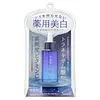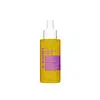What's inside
What's inside
 Key Ingredients
Key Ingredients

 Benefits
Benefits

 Concerns
Concerns

No concerns
 Ingredients Side-by-side
Ingredients Side-by-side

Tranexamic Acid
AstringentAscorbyl Glucoside
AntioxidantCeramide Ns
Skin ConditioningOryza Sativa Bran Extract
Skin ConditioningPisum Sativum Extract
Skin ConditioningHydrolyzed Conchiolin Protein
Skin ConditioningSilk Extract
Skin ConditioningCoix Lacryma-Jobi Ma-Yuen Seed Extract
Skin ConditioningGlycine Soja Extract
Skin Conditioning1,4-Cyclohexanedicarboxylic Acid
Glycerin
HumectantButylene Glycol
HumectantPolyglycerin-6
HumectantAlcohol Denat.
AntimicrobialPotassium Hydroxide
BufferingPEG-8 Castor Oil
EmulsifyingHedta
AbsorbentPolyvinylalcohol Crosspolymer
Polysorbate 20
EmulsifyingSodium Citrate
BufferingCitric Acid
BufferingSodium Metabisulfite
AntioxidantPhenoxyethanol
PreservativeSodium Paraben
PreservativeWater
Skin ConditioningTranexamic Acid, Ascorbyl Glucoside, Ceramide Ns, Oryza Sativa Bran Extract, Pisum Sativum Extract, Hydrolyzed Conchiolin Protein, Silk Extract, Coix Lacryma-Jobi Ma-Yuen Seed Extract, Glycine Soja Extract, 1,4-Cyclohexanedicarboxylic Acid, Glycerin, Butylene Glycol, Polyglycerin-6, Alcohol Denat., Potassium Hydroxide, PEG-8 Castor Oil, Hedta, Polyvinylalcohol Crosspolymer, Polysorbate 20, Sodium Citrate, Citric Acid, Sodium Metabisulfite, Phenoxyethanol, Sodium Paraben, Water
Water
Skin ConditioningNiacinamide
SmoothingMethylpropanediol
SolventGlycerin
HumectantPanthenol
Skin ConditioningTranexamic Acid
Astringent1,2-Hexanediol
Skin ConditioningKojic Acid
AntioxidantHippophae Rhamnoides Extract
MaskingAscorbyl Glucoside
AntioxidantDipropylene Glycol
HumectantHydroxyacetophenone
AntioxidantGlutathione
Butylene Glycol
HumectantCaprylyl Glycol
EmollientCarbomer
Emulsion StabilisingArginine
MaskingTocopherol
AntioxidantGlycereth-26
HumectantDisodium EDTA
Betaine
HumectantPhellodendron Amurense Bark Extract
Skin ConditioningAstragalus Membranaceus Root Extract
EmollientScutellaria Baicalensis Root Extract
AstringentCoptis Chinensis Root Extract
AntioxidantBisabolol
MaskingDipotassium Glycyrrhizate
HumectantSodium Hyaluronate
HumectantEthylhexylglycerin
Skin ConditioningHexapeptide-9
Skin ConditioningPalmitoyl Pentapeptide-4
Skin ConditioningPalmitoyl Tripeptide-1
Skin ConditioningPalmitoyl Tetrapeptide-7
Skin ConditioningAcetyl Hexapeptide-8
HumectantNonapeptide-1
Skin ConditioningWater, Niacinamide, Methylpropanediol, Glycerin, Panthenol, Tranexamic Acid, 1,2-Hexanediol, Kojic Acid, Hippophae Rhamnoides Extract, Ascorbyl Glucoside, Dipropylene Glycol, Hydroxyacetophenone, Glutathione, Butylene Glycol, Caprylyl Glycol, Carbomer, Arginine, Tocopherol, Glycereth-26, Disodium EDTA, Betaine, Phellodendron Amurense Bark Extract, Astragalus Membranaceus Root Extract, Scutellaria Baicalensis Root Extract, Coptis Chinensis Root Extract, Bisabolol, Dipotassium Glycyrrhizate, Sodium Hyaluronate, Ethylhexylglycerin, Hexapeptide-9, Palmitoyl Pentapeptide-4, Palmitoyl Tripeptide-1, Palmitoyl Tetrapeptide-7, Acetyl Hexapeptide-8, Nonapeptide-1
 Reviews
Reviews

Alternatives
Ingredients Explained
These ingredients are found in both products.
Ingredients higher up in an ingredient list are typically present in a larger amount.
Ascorbyl Glucoside is a stable form of Vitamin C. It is created by combining glucose from starch.
When applied to skin, Ascorbyl Glucoside turns into Ascorbic Acid.
Ascorbyl Glucoside is an antioxidant. Antioxidants help fight free-radicals, or molecules that may damage skin cells.
It can help to reduce redness, improve skin texture, reduce the effects of aging, reduce the visibility of dark spots, and brighten skin.
Read more about other types of Vitamin C:
Learn more about Ascorbyl GlucosideButylene Glycol (or BG) is used within cosmetic products for a few different reasons:
Overall, Butylene Glycol is a safe and well-rounded ingredient that works well with other ingredients.
Though this ingredient works well with most skin types, some people with sensitive skin may experience a reaction such as allergic rashes, closed comedones, or itchiness.
Learn more about Butylene GlycolGlycerin is already naturally found in your skin. It helps moisturize and protect your skin.
A study from 2016 found glycerin to be more effective as a humectant than AHAs and hyaluronic acid.
As a humectant, it helps the skin stay hydrated by pulling moisture to your skin. The low molecular weight of glycerin allows it to pull moisture into the deeper layers of your skin.
Hydrated skin improves your skin barrier; Your skin barrier helps protect against irritants and bacteria.
Glycerin has also been found to have antimicrobial and antiviral properties. Due to these properties, glycerin is often used in wound and burn treatments.
In cosmetics, glycerin is usually derived from plants such as soybean or palm. However, it can also be sourced from animals, such as tallow or animal fat.
This ingredient is organic, colorless, odorless, and non-toxic.
Glycerin is the name for this ingredient in American English. British English uses Glycerol/Glycerine.
Learn more about GlycerinTranexamic Acid is best used for treating hyperpigmentation, discoloration, and melasma. It can also help build a stronger skin barrier.
Once applied, Tranexamic Acid starts decreasing inflammation from UV exposure. Tranexamic Acid also prevents our skin cells from meeting the pigment production cells.
Its brightening property makes it great at reducing the appearance of acne scars and marks.
Fun fact: Tranexamic Acid is also a medication used to reduce heavy bleeding.
This acid is derived from lysine, an amino acid.
Learn more about Tranexamic AcidWater. It's the most common cosmetic ingredient of all. You'll usually see it at the top of ingredient lists, meaning that it makes up the largest part of the product.
So why is it so popular? Water most often acts as a solvent - this means that it helps dissolve other ingredients into the formulation.
You'll also recognize water as that liquid we all need to stay alive. If you see this, drink a glass of water. Stay hydrated!
Learn more about Water